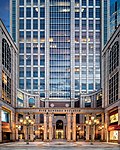YWCA Boston building (Clarendon Street)

The YWCA Boston building is a historic building located at 140 Clarendon Street in the Back Bay neighborhood of Boston, Massachusetts. The 13-story brick-faced steel-frame building was designed by George F. Shepard and Frederic Stearns, and built in 1929. The building once housed an indoor swimming pool and recreation facilities for the YWCA Boston; it is now operated by Clarendon Residences LLC, which provides affordable and market-rate housing, the boutique hotel Hotel 140, facilities for the Lyric Stage of Boston and Snowden International High School, and corporate offices for several small and mid-sized for-profit and not-for-profit tenants. The building was listed on the National Register of Historic Places in 2004.
Excerpt from the Wikipedia article YWCA Boston building (Clarendon Street) (License: CC BY-SA 3.0, Authors, Images).YWCA Boston building (Clarendon Street)
Clarendon Street, Boston Back Bay
Geographical coordinates (GPS) Address Nearby Places Show on map
Geographical coordinates (GPS)
| Latitude | Longitude |
|---|---|
| N 42.348627777778 ° | E -71.074372222222 ° |
Address
Clarendon Street 140
02116 Boston, Back Bay
Massachusetts, United States
Open on Google Maps







